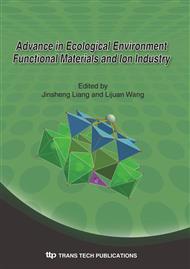p.1
p.7
p.15
p.21
p.29
p.35
p.41
Chemical Reaction Characteristics of HDTMA+ Cations in Interlayer Space of Vermiculite Crystal Layers
Abstract:
Hydrophlogopite, a regular interstratified mineral with 1:1 ratio of vermiculite and phlogopite crystal layers, was modified with sodium and organically intercalated with HDTMAB, and then the samples were examined with XRD. Based on the theoretical geometric dimensions of organic cations, the structure and arrangement model of HDTMA+ cation in the interlayer space of vermiculite crystal layers were studied, the reaction mechanism of organic intercalation was also discussed. The results show that HDTMA+ cations enter into the interlayer space of vermiculite crystal layers only without exchange with the cations in the interlayer space of phlogopite crystal layers, and that the arrangement models of HDTMA+ cations in the interlayer space of vermiculite crystal layers varies with the added amount of HDTMAB. When the added amount is small, the arrangement model of HDTMA+ cations in the interlayer space of vermiculite crystal layers is lateral-bilayer, and when the added amount is larger, the arrangement model is paraffin-type monolayer.
Info:
Periodical:
Pages:
15-20
Citation:
Online since:
January 2010
Authors:
Keywords:
Price:
Сopyright:
© 2010 Trans Tech Publications Ltd. All Rights Reserved
Share:
Citation:


